Abstract
Thirteen pigeons were exposed to a variety of second-order schedules in which responding under a component schedule was reinforced according to a schedule of reinforcement. Under different conditions, completion of each component resulted in either (1) the brief presentation of a stimulus also present during reinforcement (pairing operation), (2) the brief presentation of a stimulus not present during reinforcement (nonpairing operation), or (3) no brief stimulus presentation (tandem). Brief-stimulus presentations engendered a pattern of responding within components similar to that engendered by food. Patterning was observed when fixed-interval and fixed-ratio components were maintained under fixed- and variable-ratio and fixed- and variable-interval schedules. There were no apparent differences in performance under pairing and nonpairing conditions in any study. The properties of the stimuli presented in brief-stimulus operations produced different effects on response patterning. In one study, similar effects on performance were found whether brief-stimulus presentations were response-produced or delivered independently of responding. Response patterning did not occur when the component schedule under which a nonpaired stimulus was produced occurred independently of the food schedule. The results suggest a reevaluation of the role of conditioned reinforcement in second-order schedule performance. The similarity of behavior under pairing and nonpairing operations is consistent with two hypotheses: (1) the major effect is due to the discriminative properties of the brief stimulus; (2) the scheduling operation under which the paired or nonpaired stimulus is presented can establish it as a reinforcer.
Full text
PDF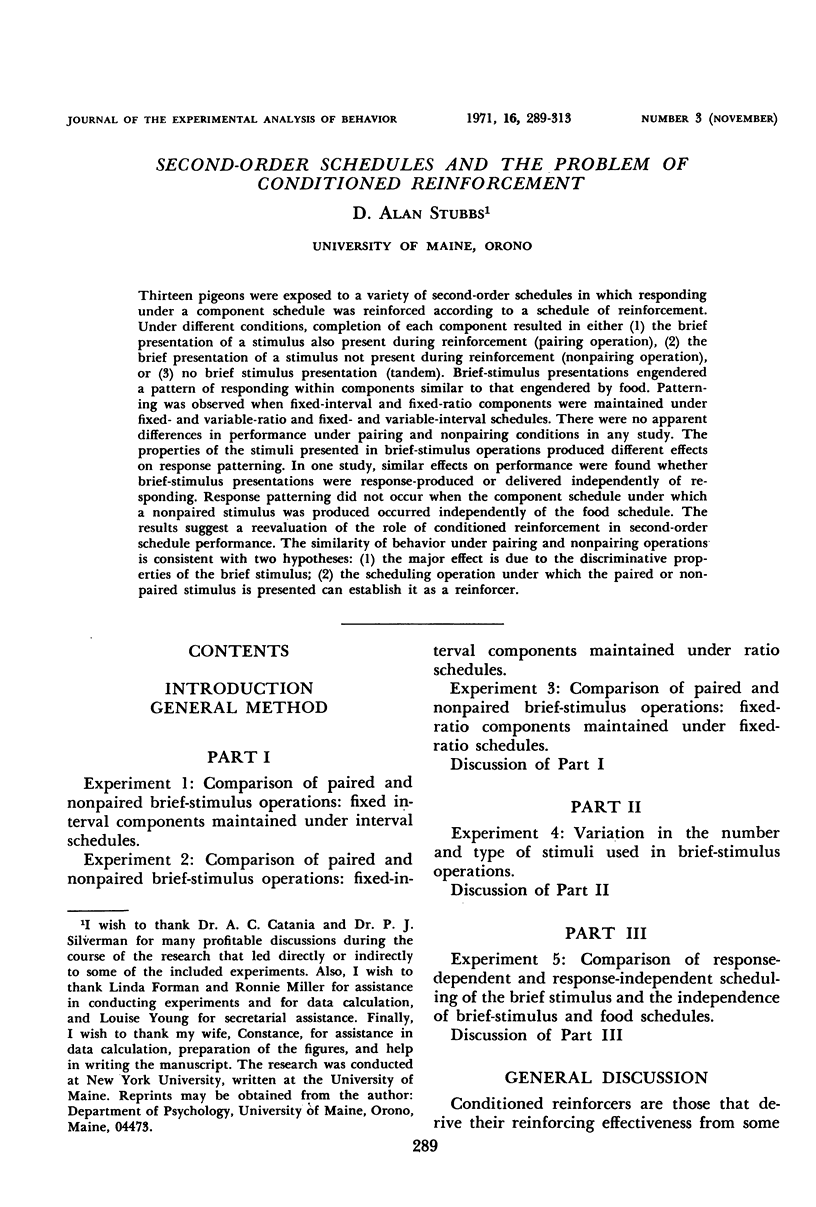
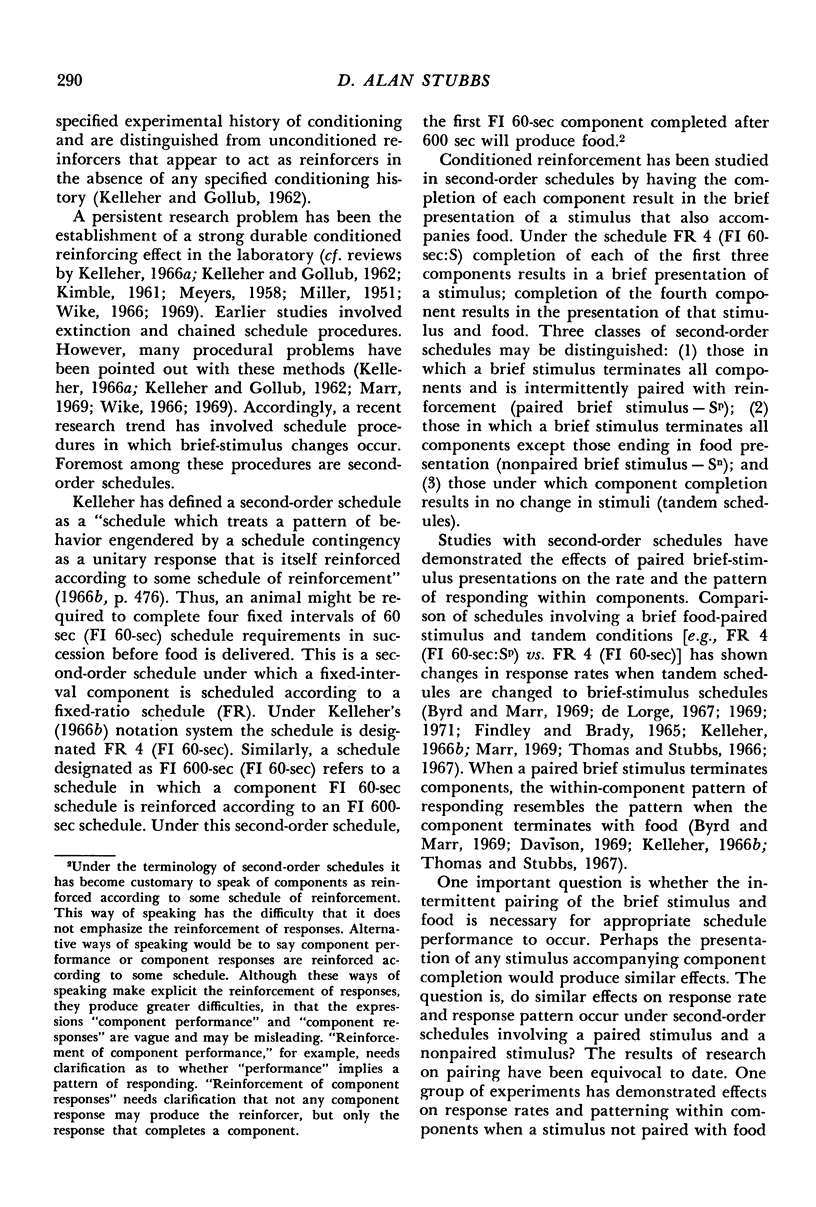
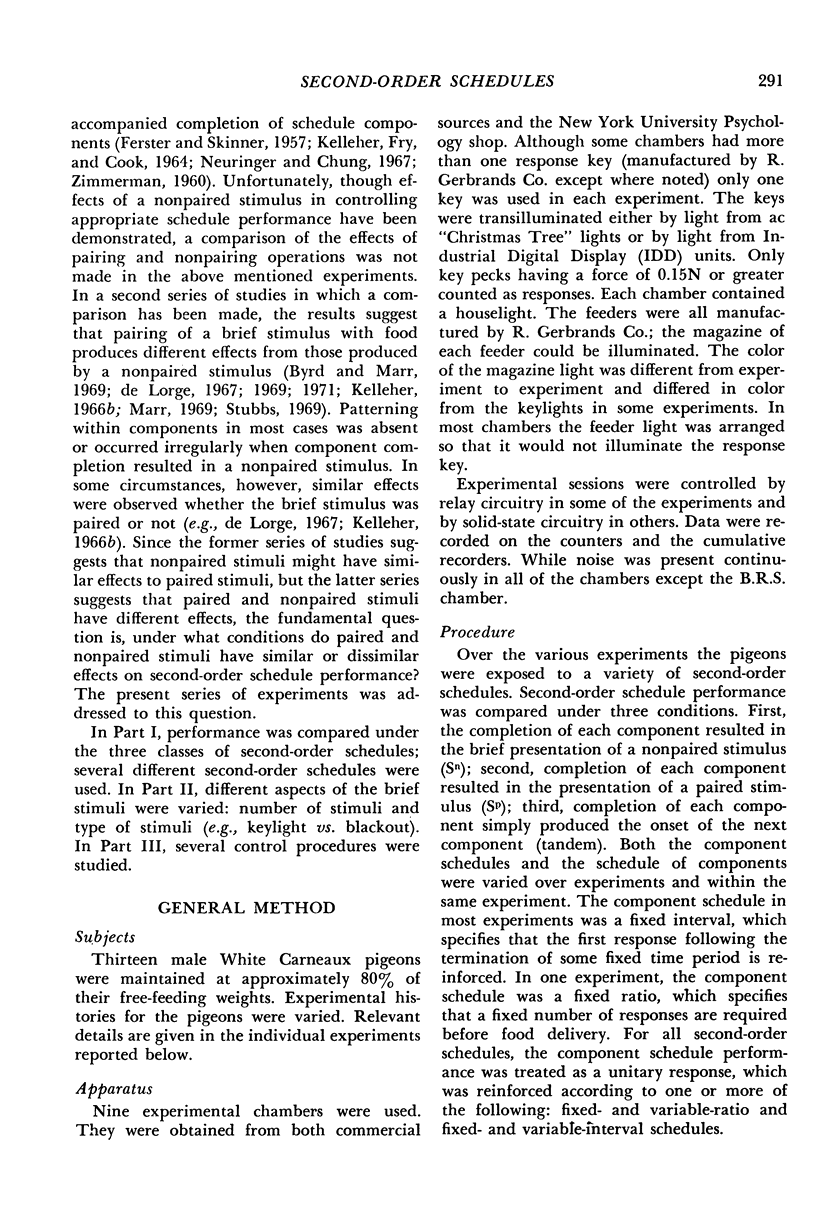
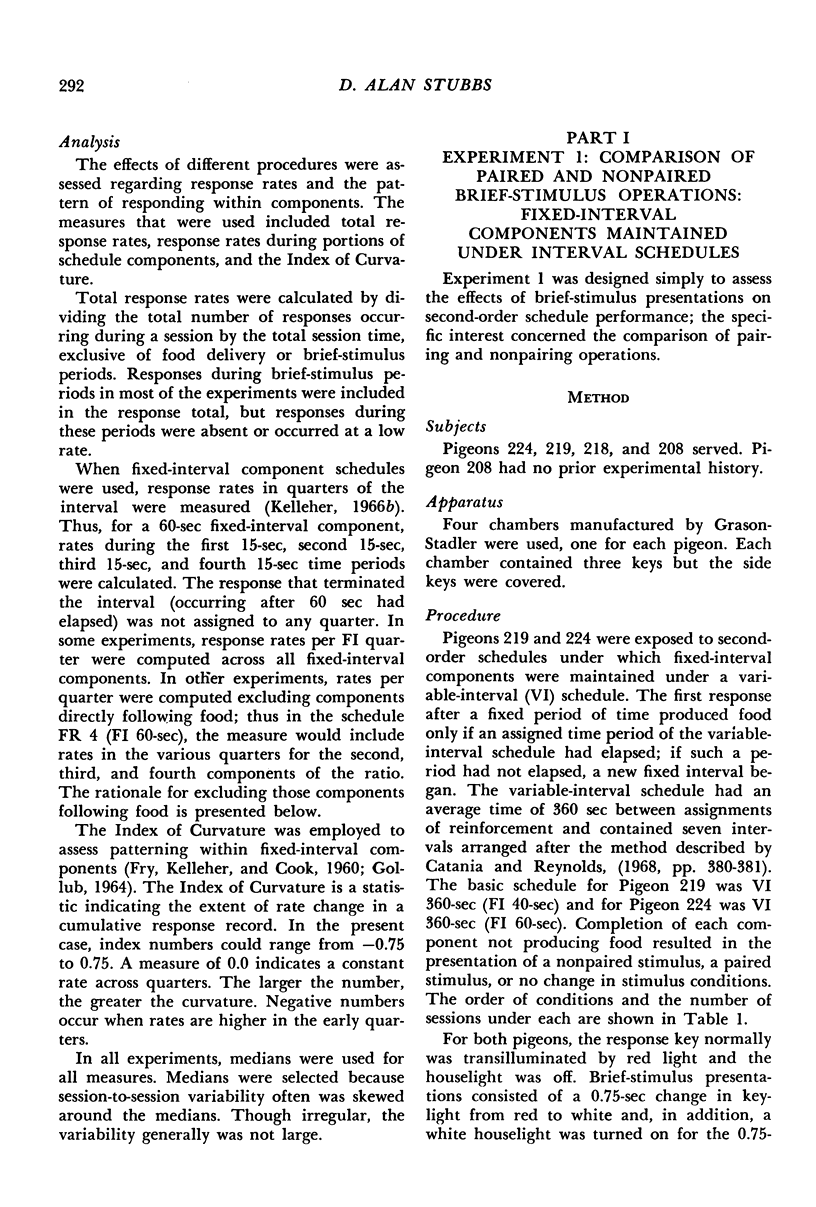
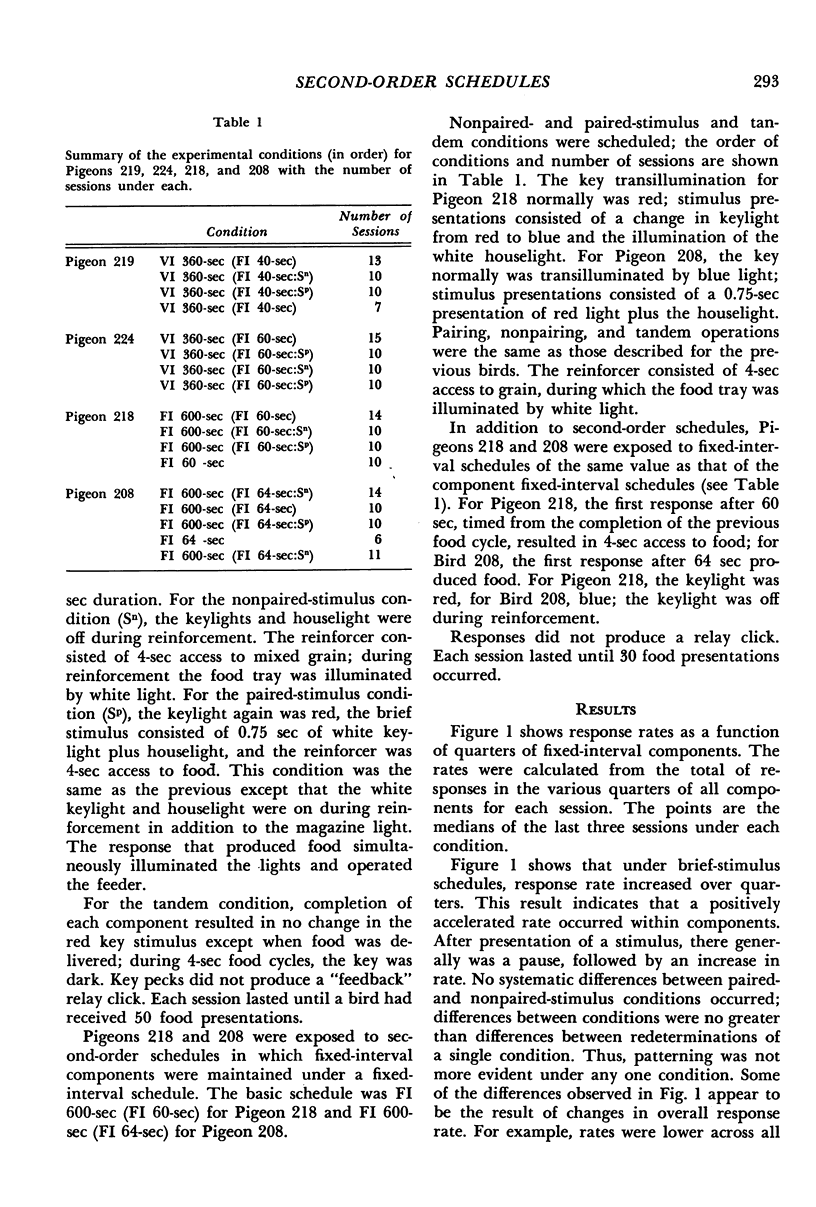
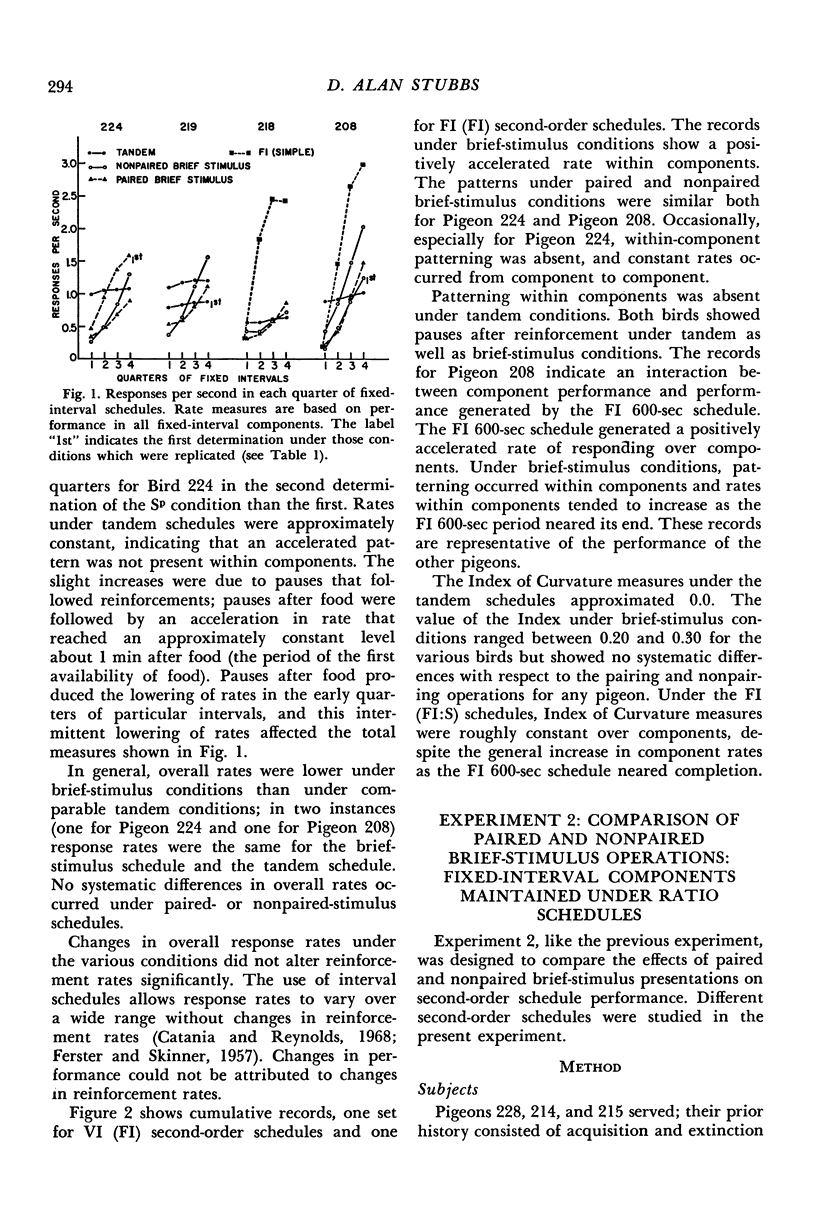
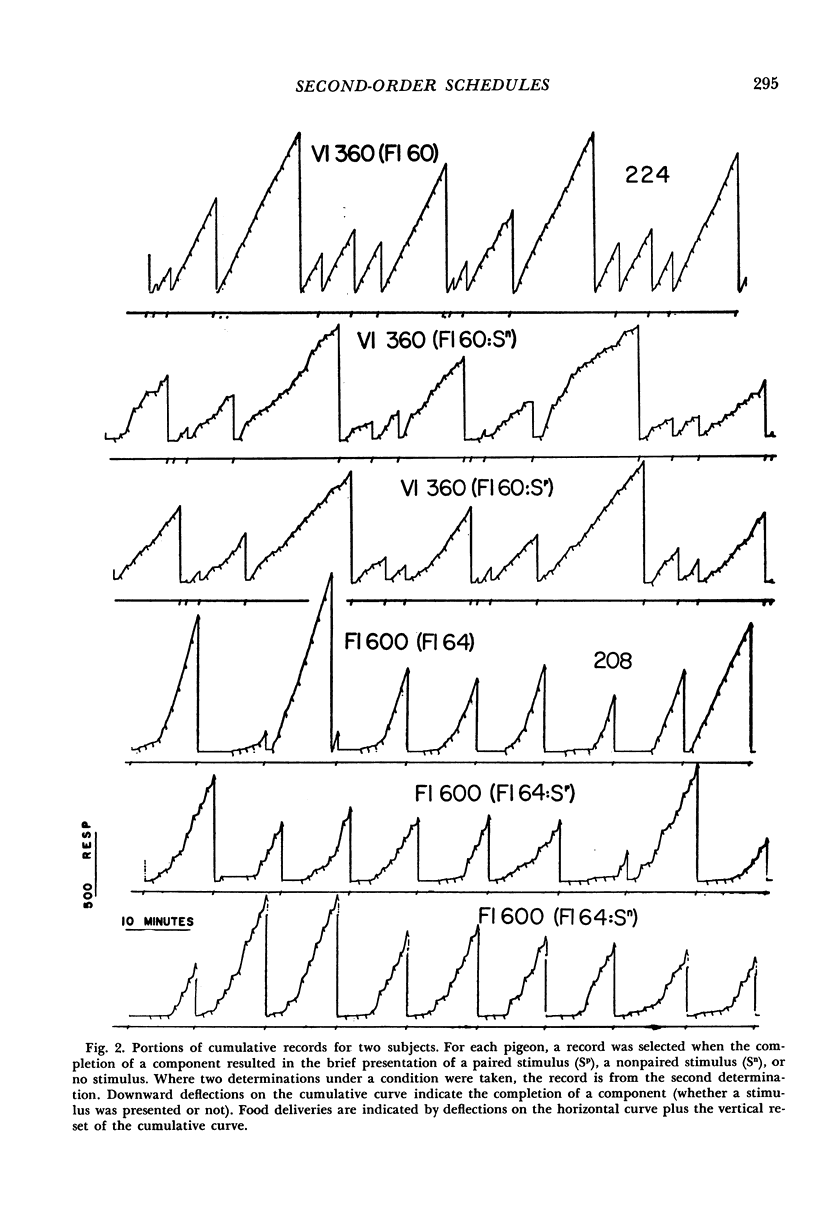
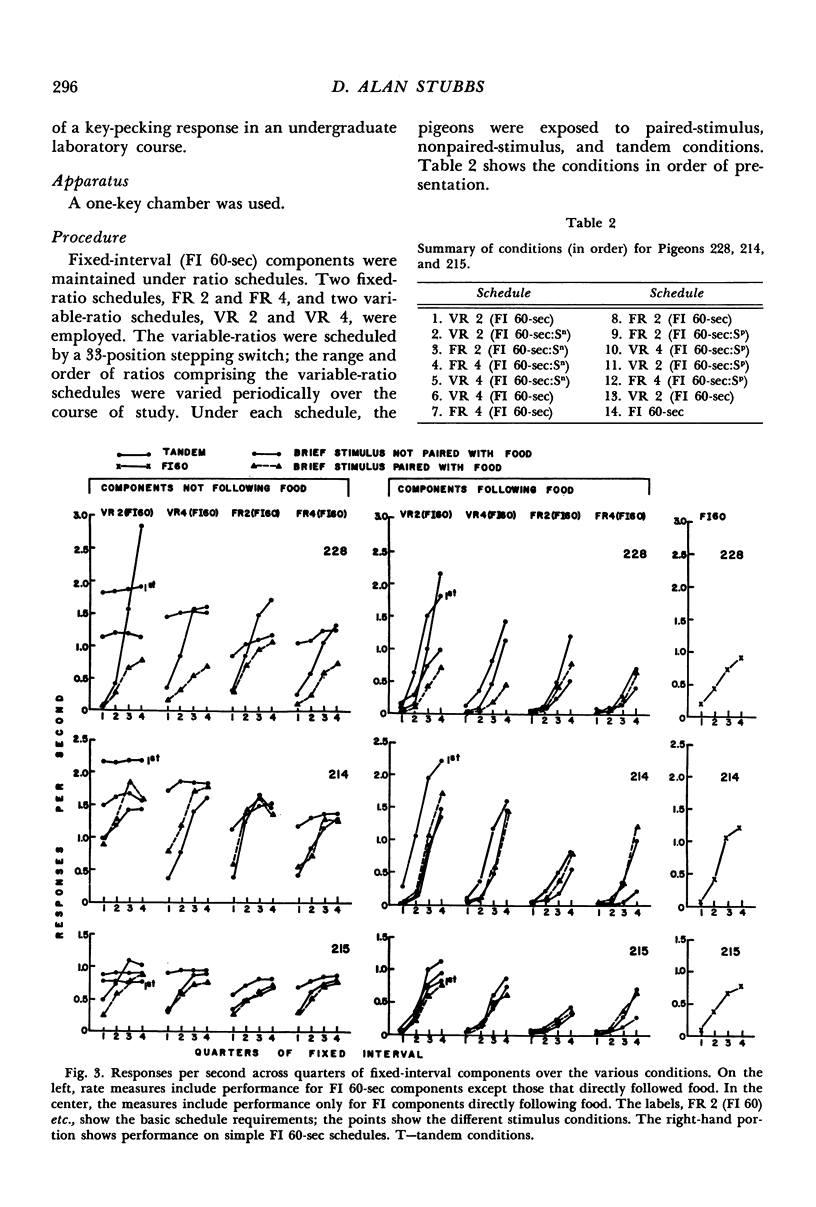
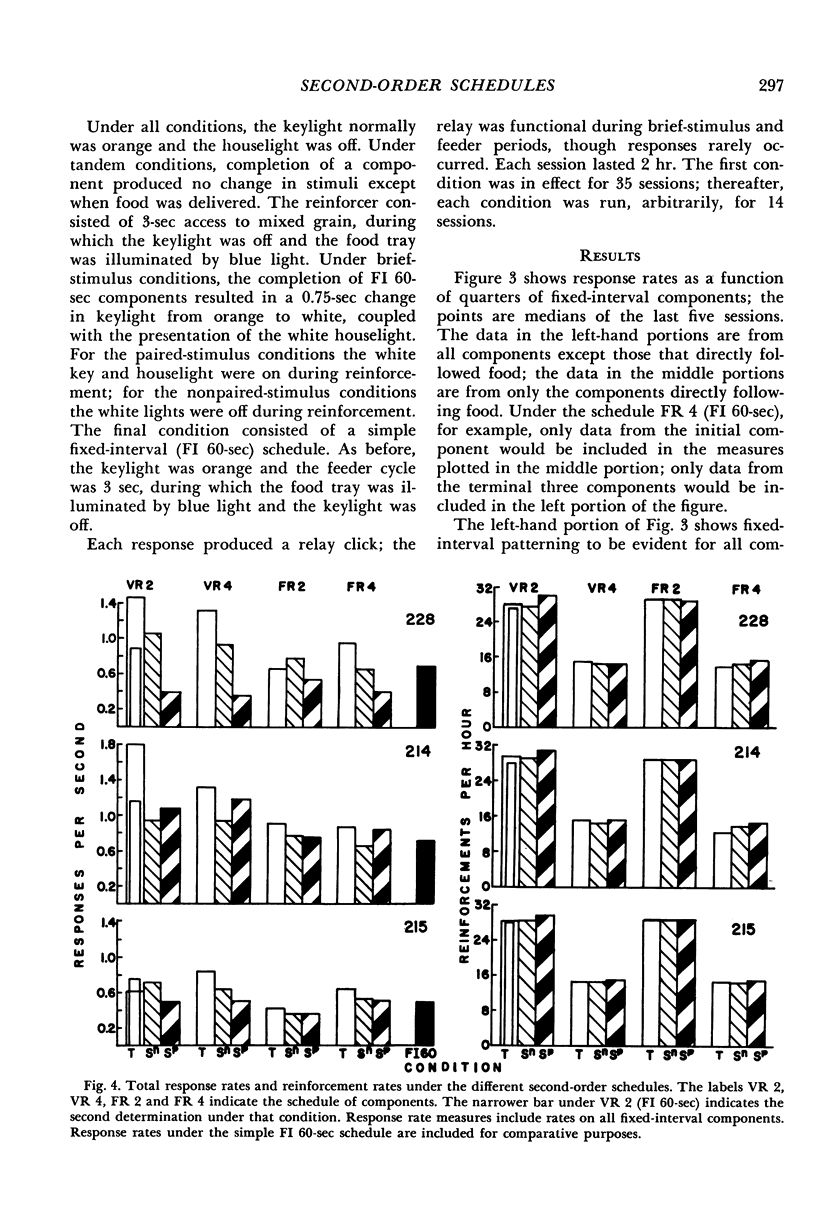
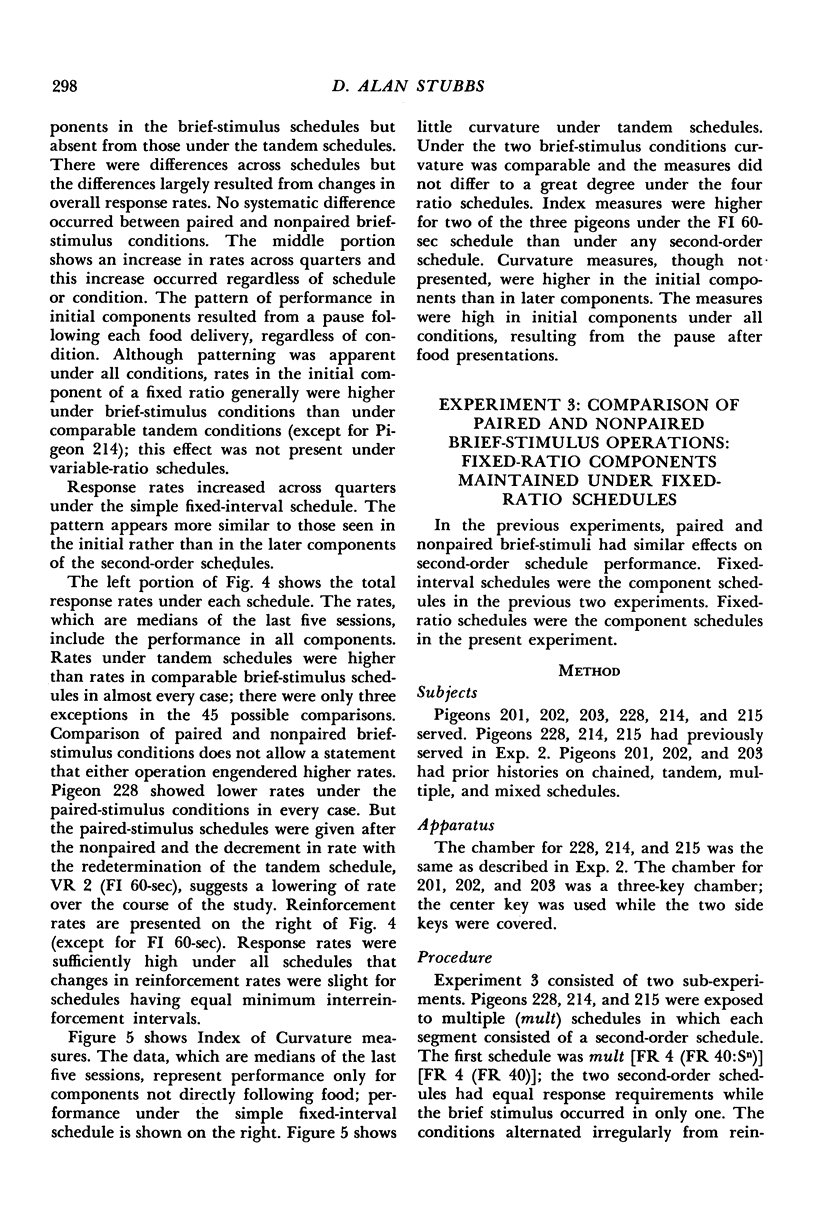
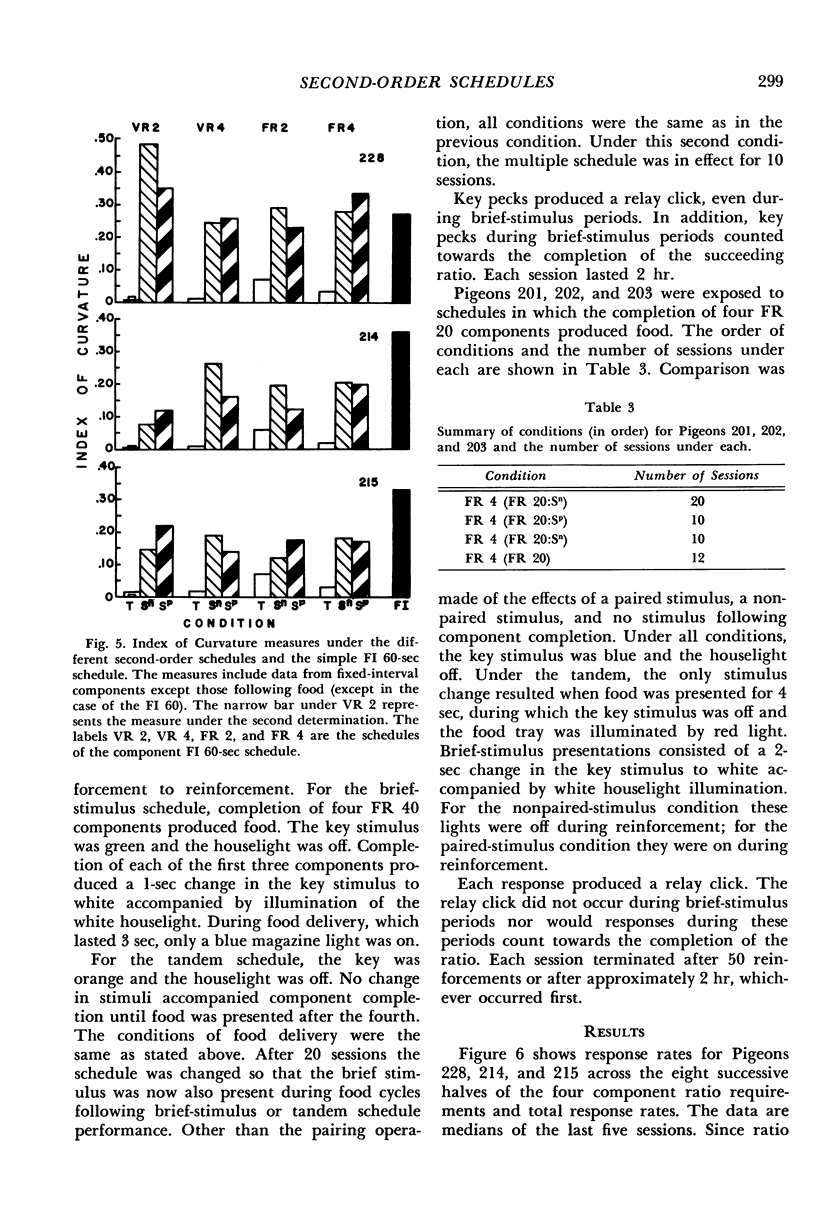
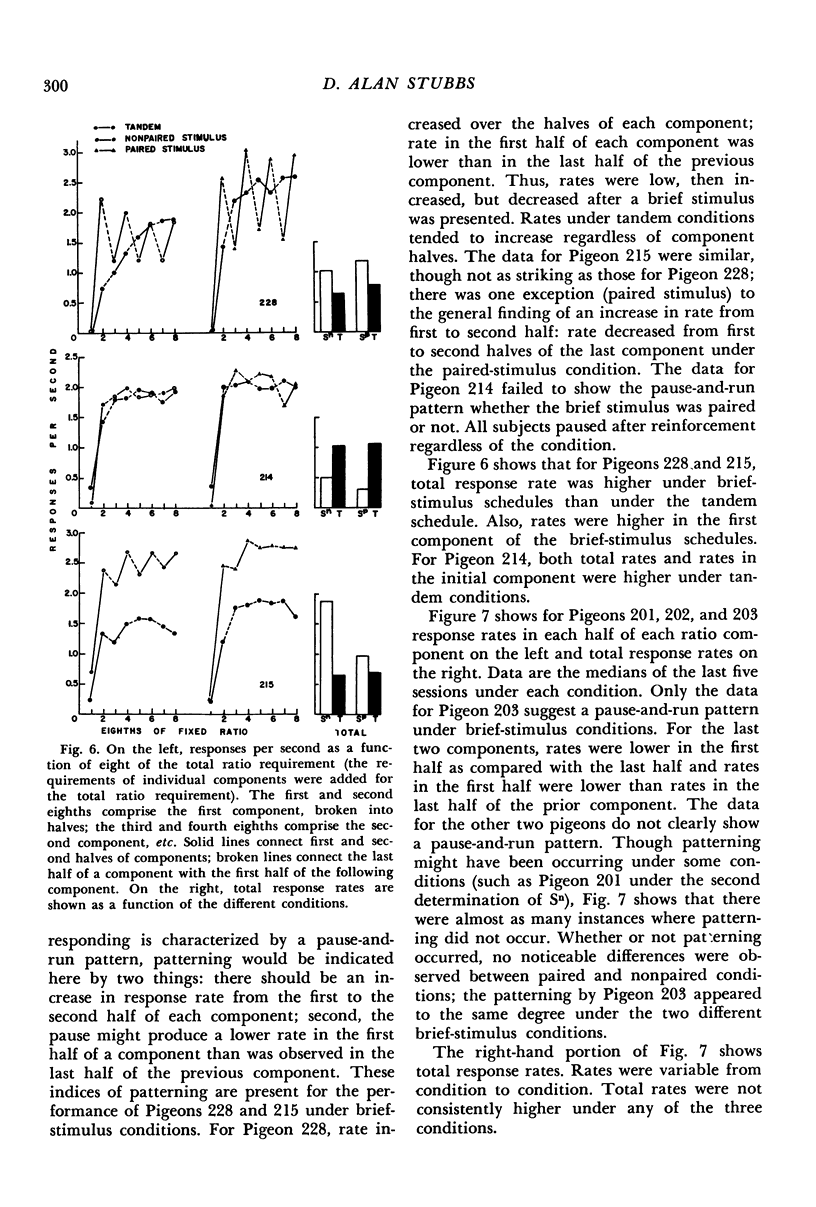
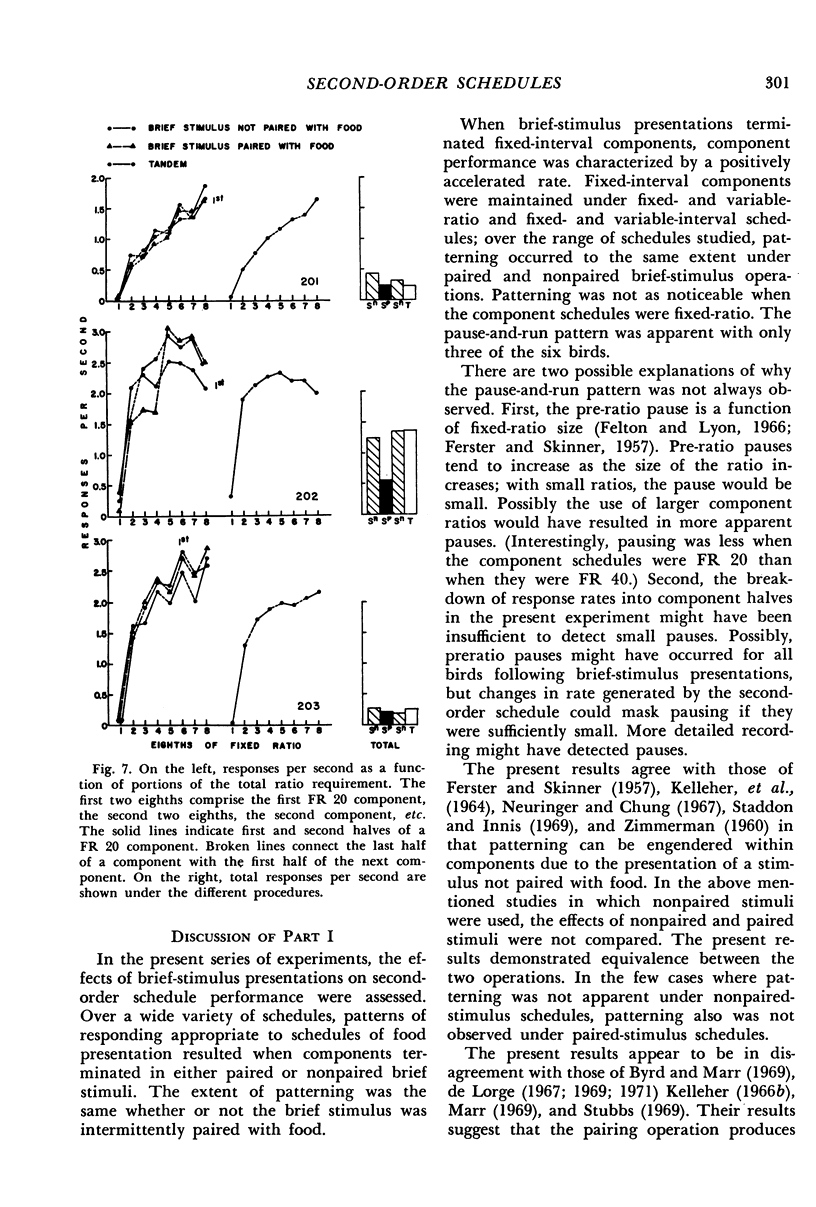
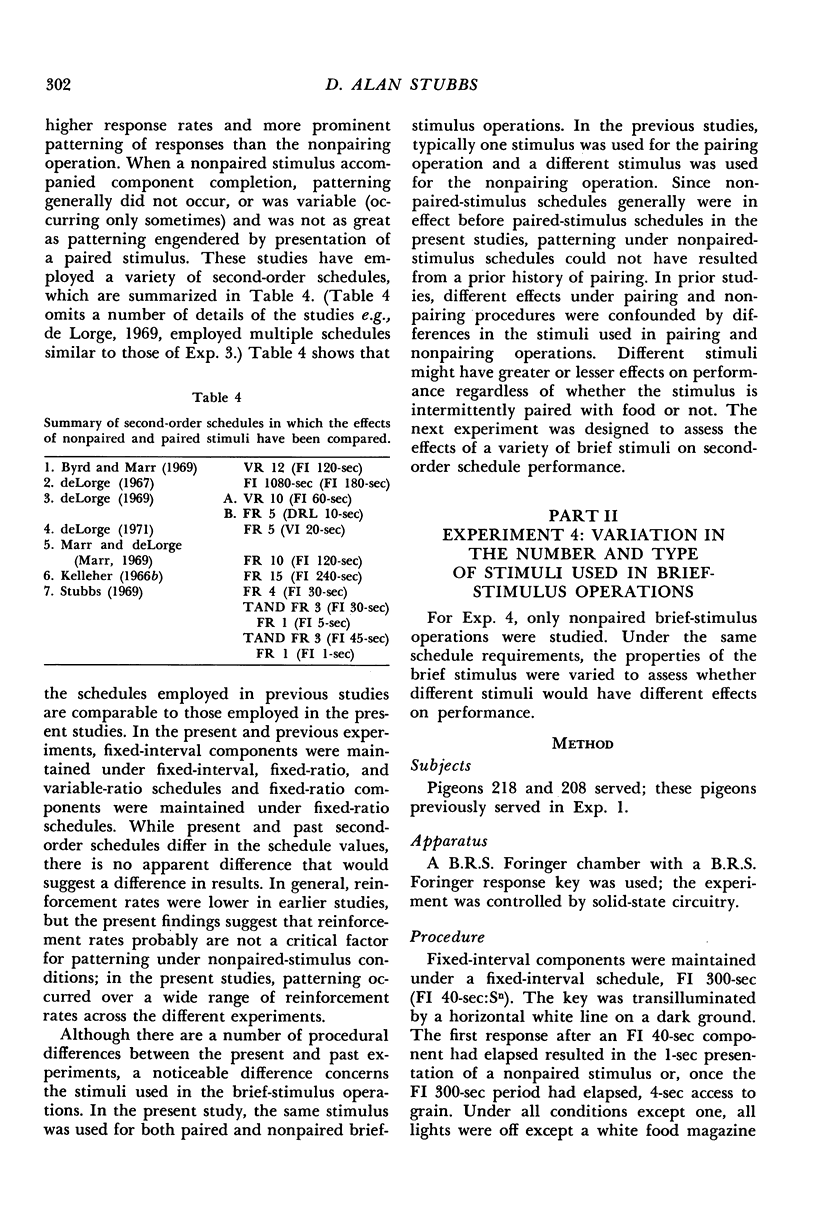
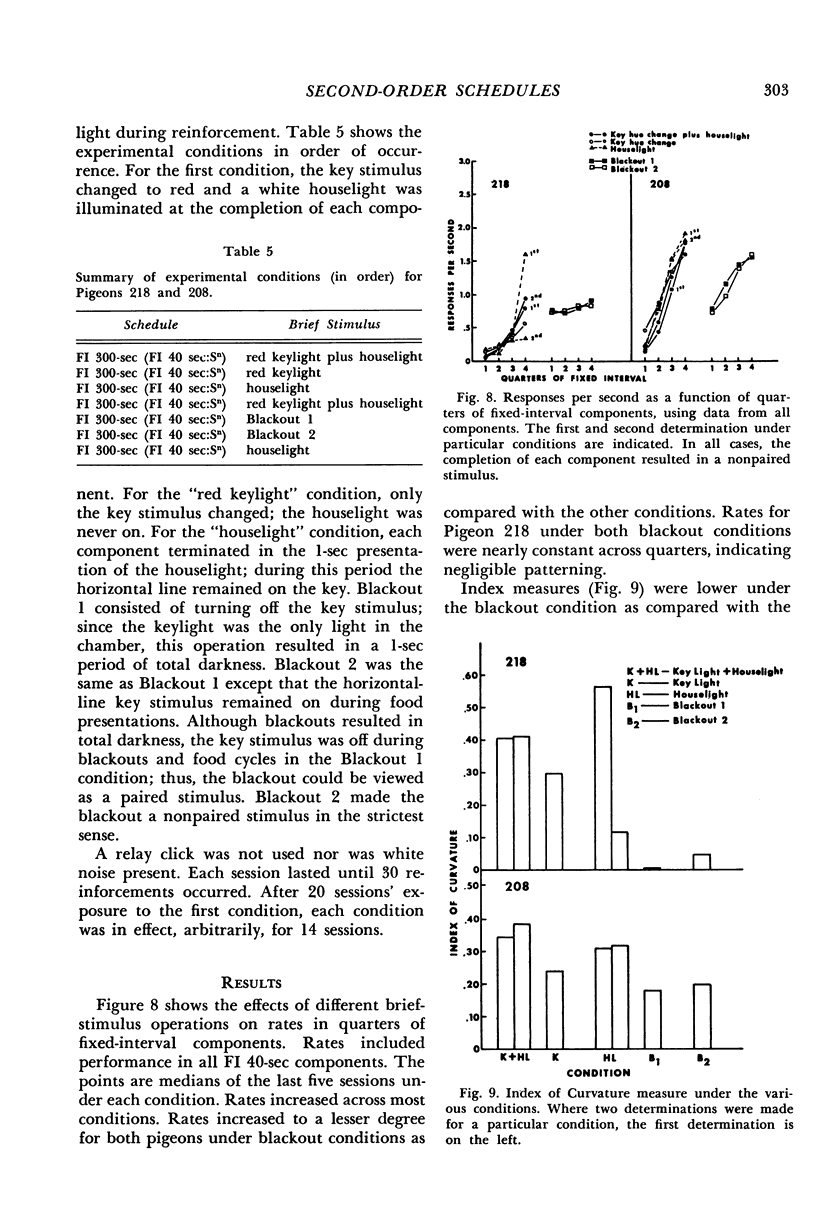
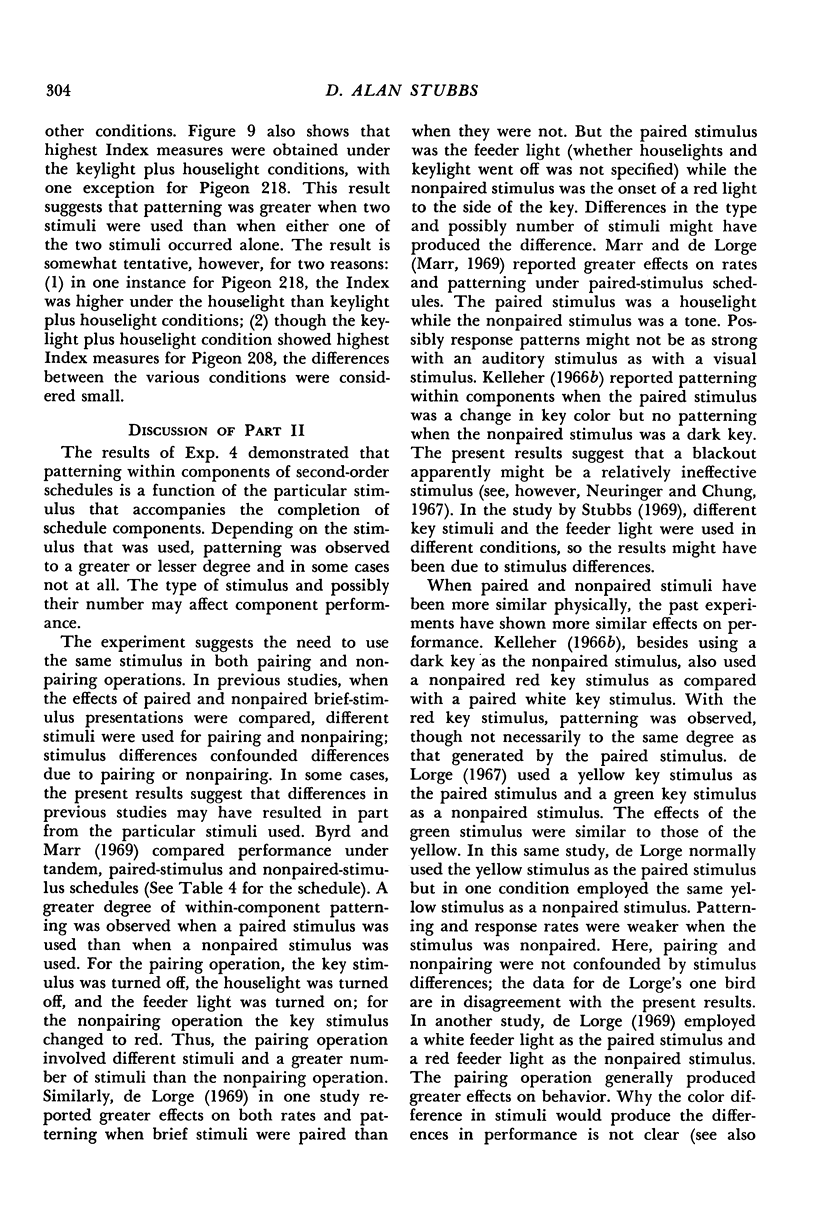
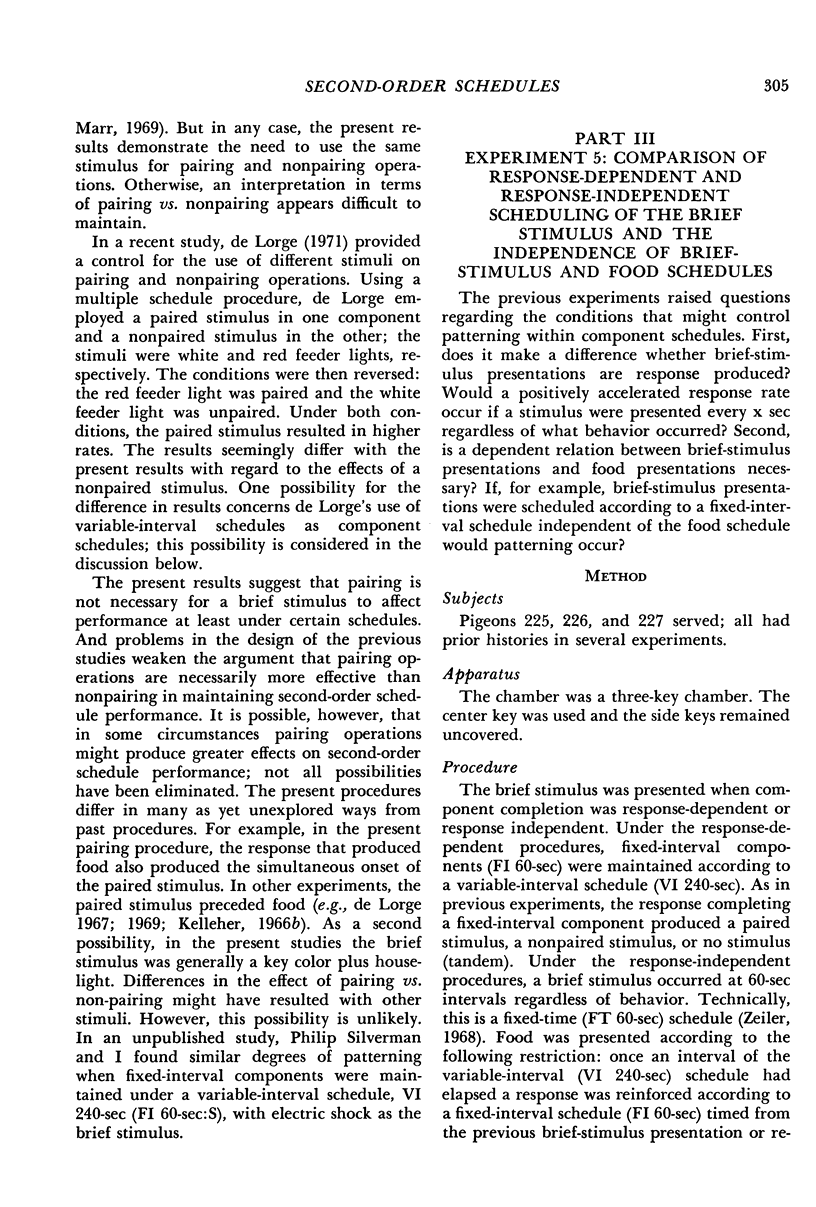
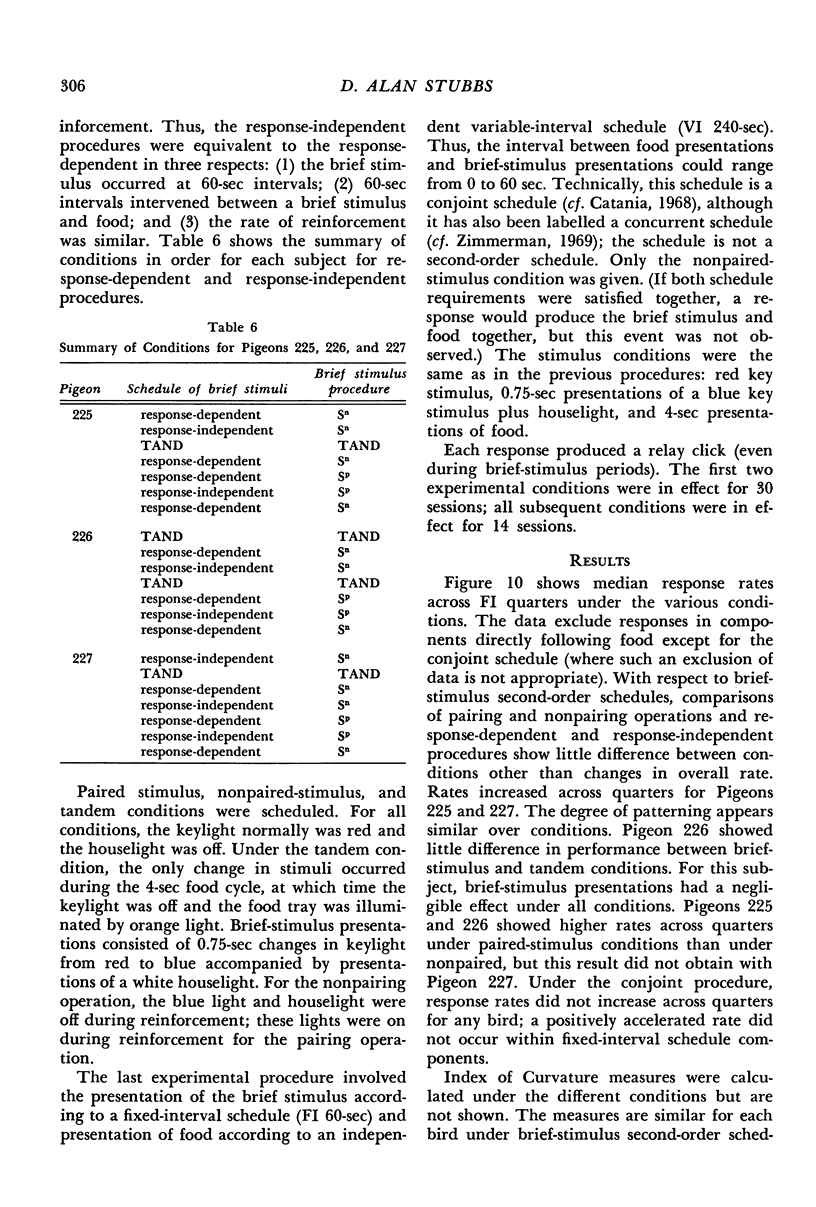
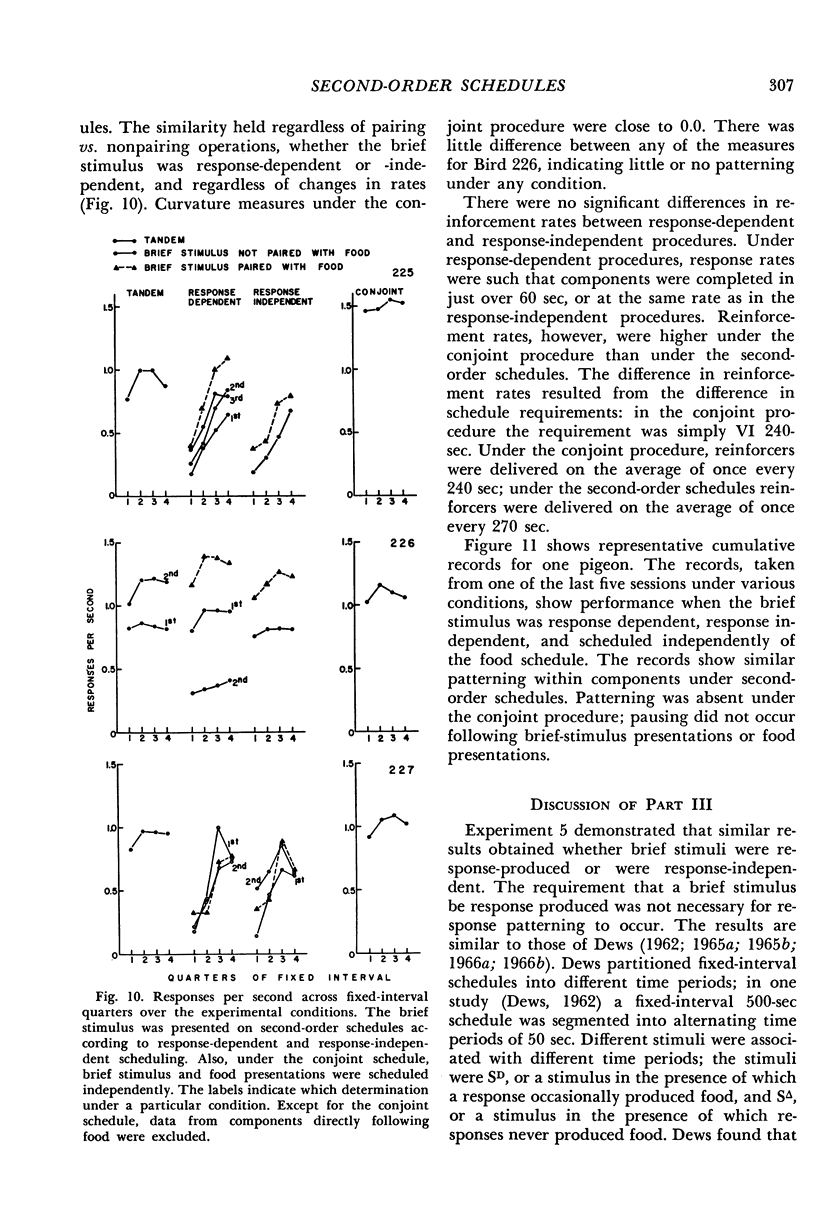
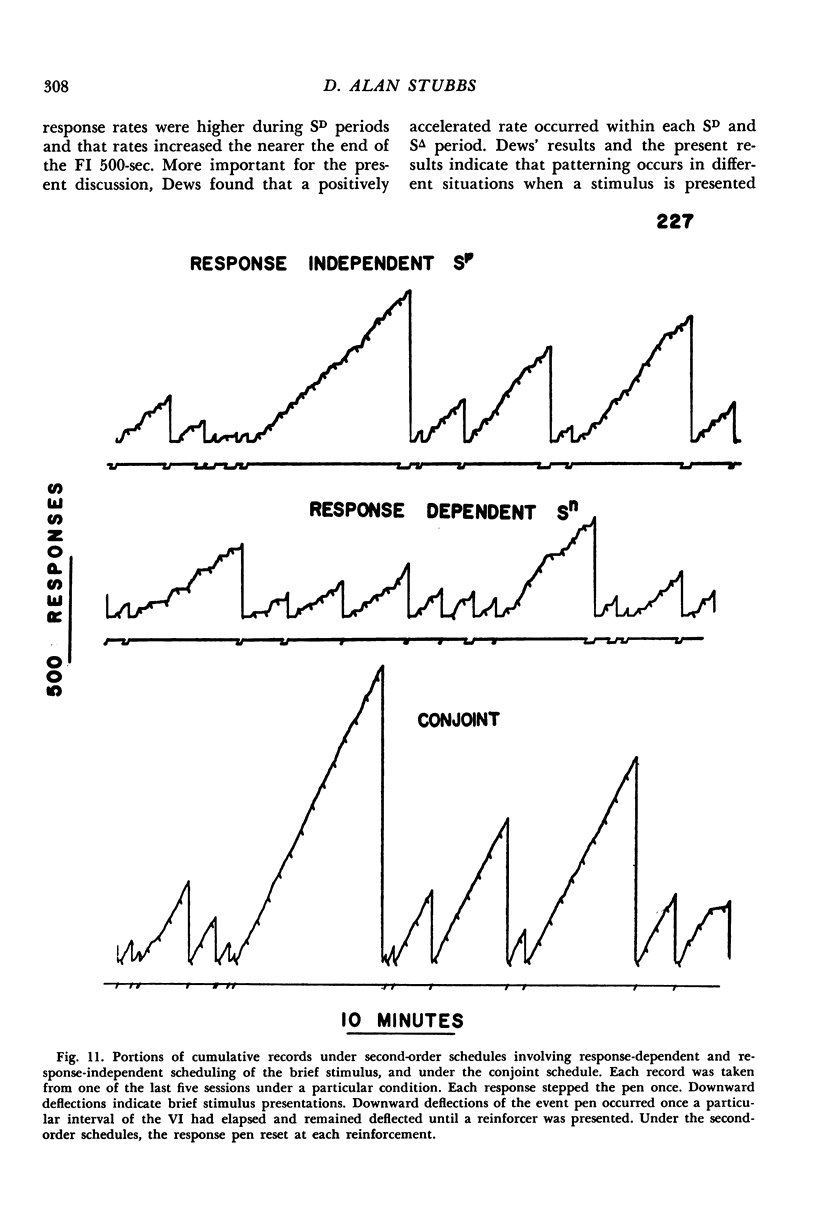
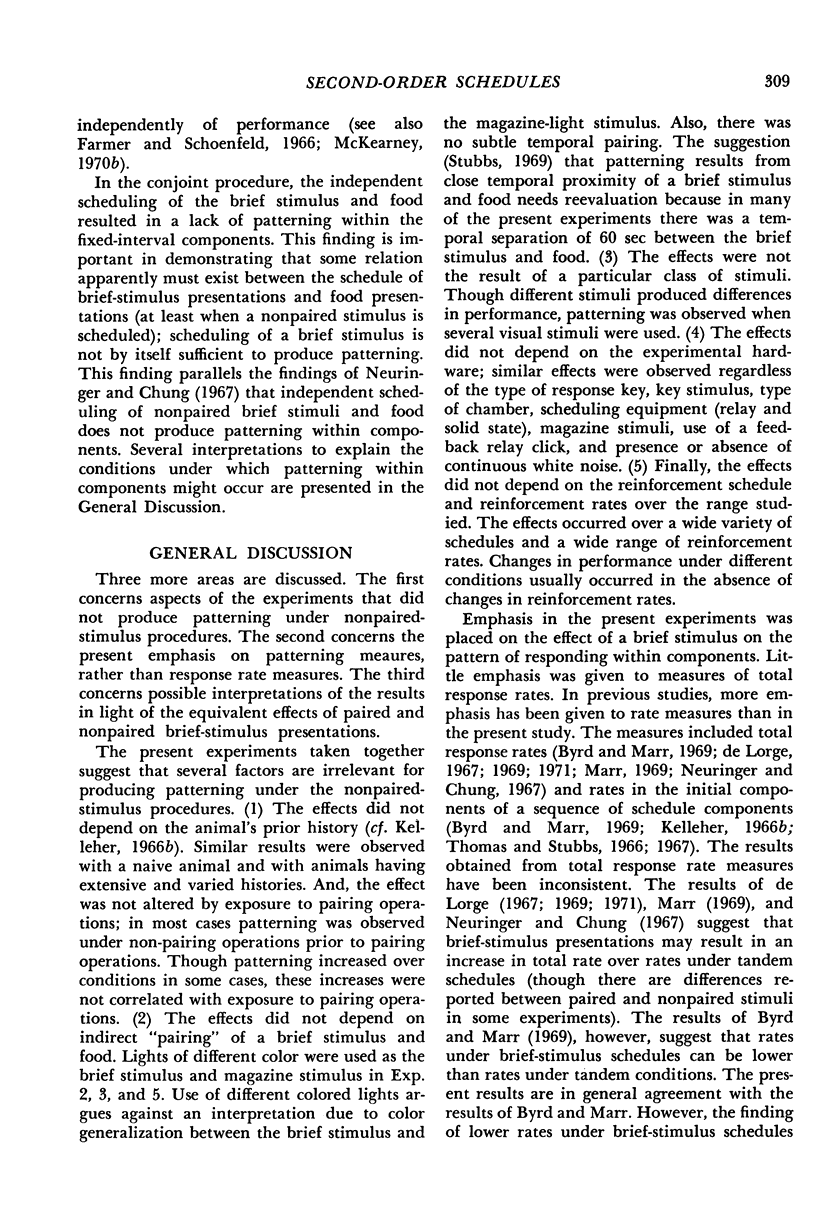
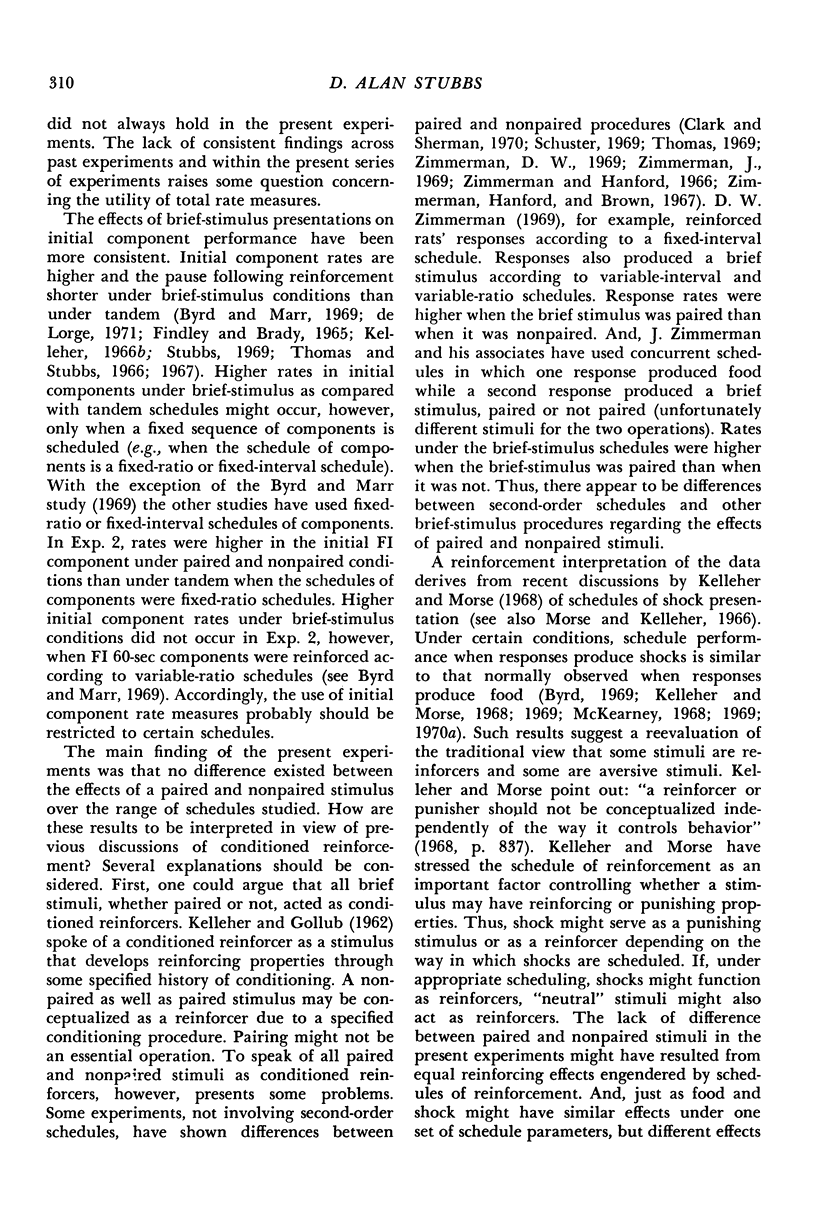
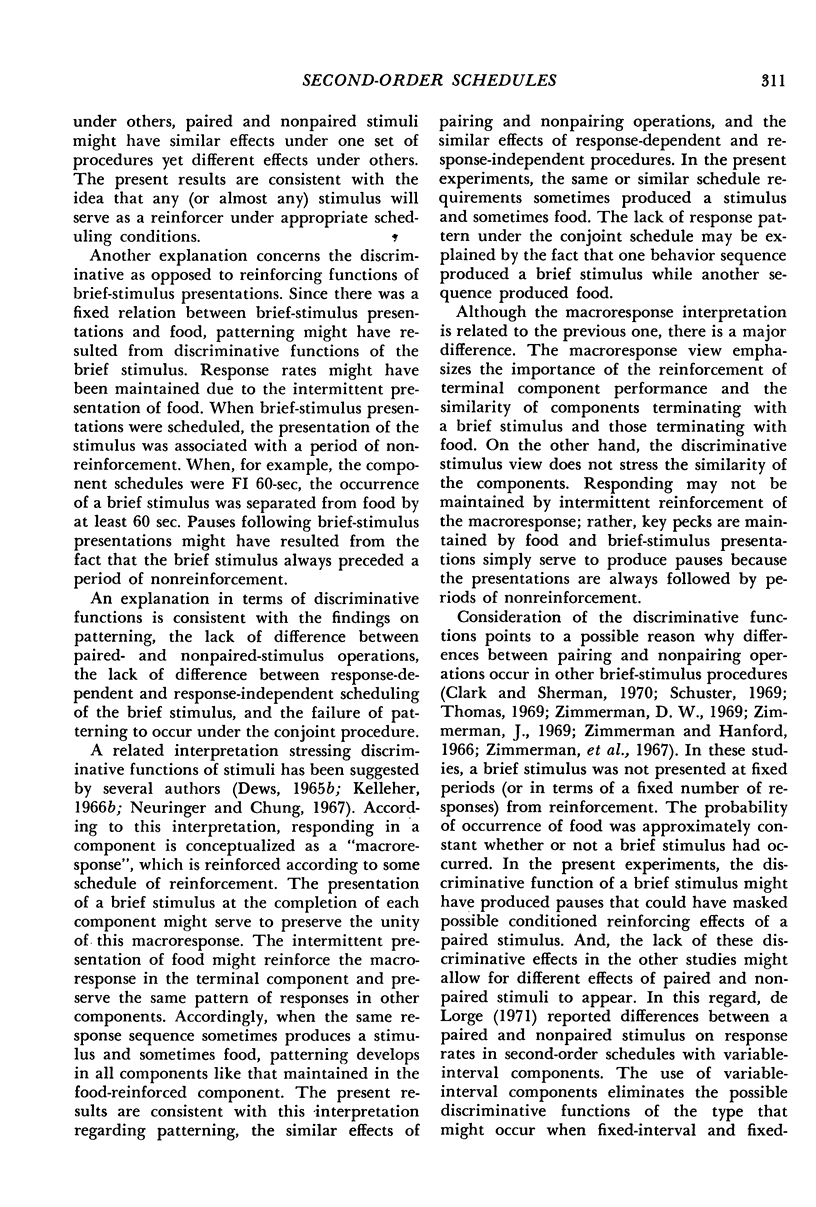
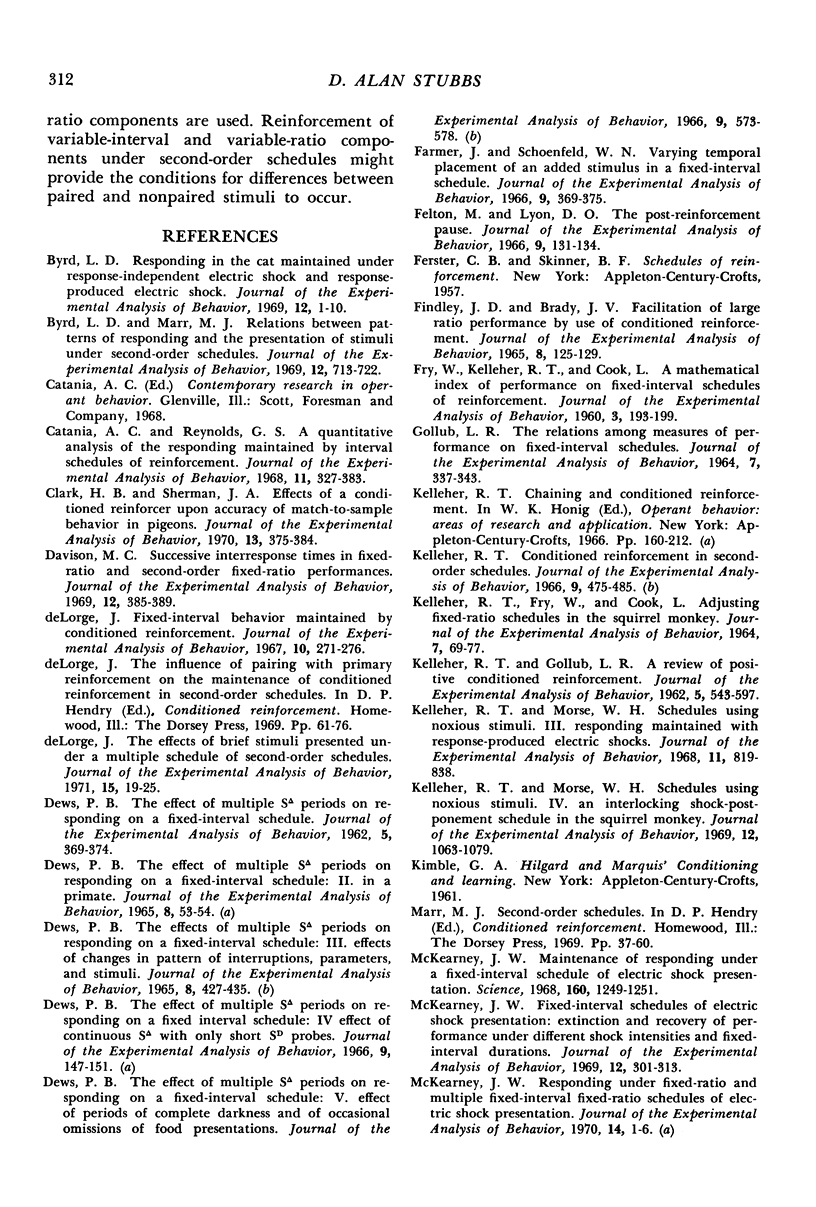
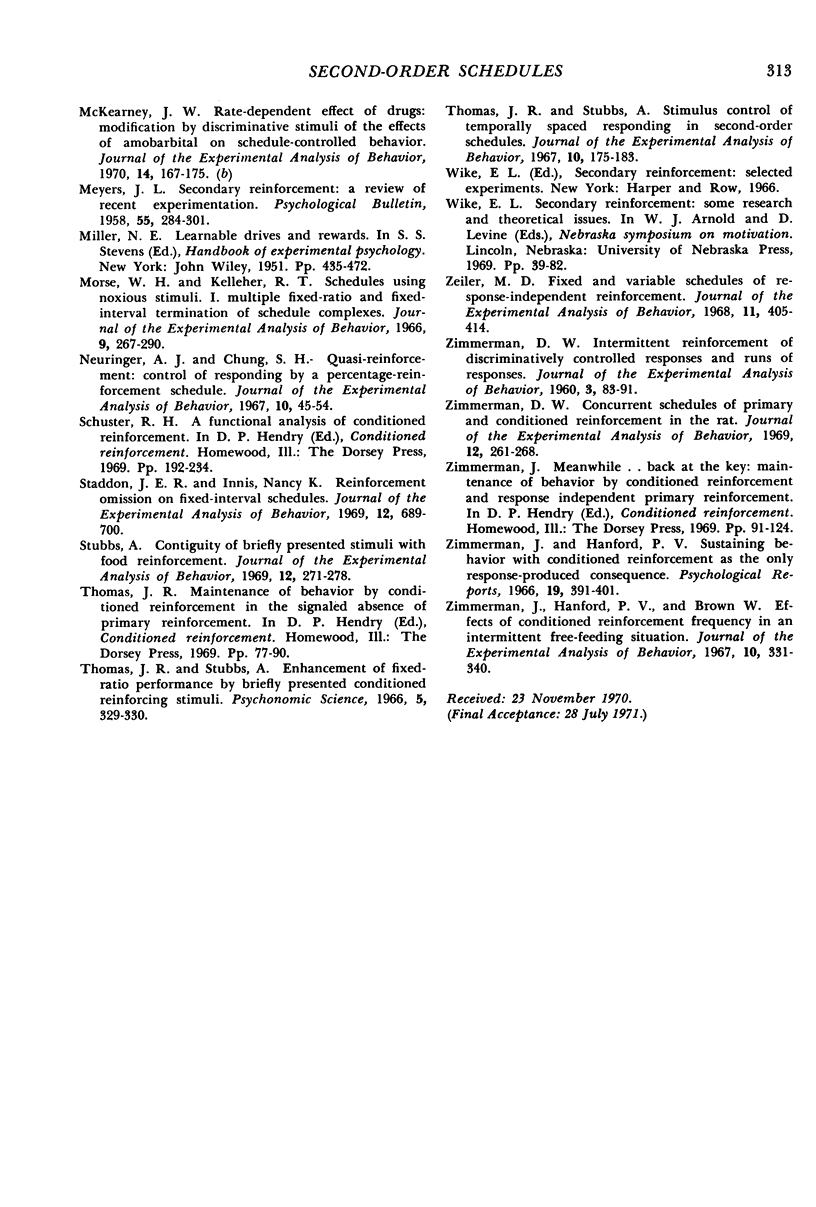
Selected References
These references are in PubMed. This may not be the complete list of references from this article.
- Byrd L. D., Marr M. J. Relations between patterns of responding and the presentation of stimuli under second-order schedules. J Exp Anal Behav. 1969 Sep;12(5):713–722. doi: 10.1901/jeab.1969.12-713. [DOI] [PMC free article] [PubMed] [Google Scholar]
- Byrd L. D. Responding in the cat maintained under response-independent electric shock and response-produced electric shock. J Exp Anal Behav. 1969 Jan;12(1):1–10. doi: 10.1901/jeab.1969.12-1. [DOI] [PMC free article] [PubMed] [Google Scholar]
- Catania A. C., Reynolds G. S. A quantitative analysis of the responding maintained by interval schedules of reinforcement. J Exp Anal Behav. 1968 May;11(3 Suppl):327–383. doi: 10.1901/jeab.1968.11-s327. [DOI] [PMC free article] [PubMed] [Google Scholar]
- Clark H. B., Sherman J. A. Effects of a conditioned reinforcer upon accuracy of match-to-sample behavior in pigeons. J Exp Anal Behav. 1970 May;13(3):375–384. doi: 10.1901/jeab.1970.13-375. [DOI] [PMC free article] [PubMed] [Google Scholar]
- DEWS P. B. THE EFFECT OF MULTIPLE S-DELTA PERIODS ON RESPONDING ON A FIXED-INTERVAL SCHEDULE. II. IN A PRIMATE. J Exp Anal Behav. 1965 Jan;8:53–54. doi: 10.1901/jeab.1965.8-53. [DOI] [PMC free article] [PubMed] [Google Scholar]
- DEWS P. B. The effect of multiple S delta periods on responding on a fixed-interval schedule. J Exp Anal Behav. 1962 Jul;5:369–374. doi: 10.1901/jeab.1962.5-369. [DOI] [PMC free article] [PubMed] [Google Scholar]
- Davison M. C. Successive interresponse times in fixed-ratio and second-order fixed-ratio performance. J Exp Anal Behav. 1969 May;12(3):385–389. doi: 10.1901/jeab.1969.12-385. [DOI] [PMC free article] [PubMed] [Google Scholar]
- De Lorge J. Fixed-interval behavior maintained by conditioned reinforcement. J Exp Anal Behav. 1967 May;10(3):271–276. doi: 10.1901/jeab.1967.10-271. [DOI] [PMC free article] [PubMed] [Google Scholar]
- De Lorge J. The effects of brief stimuli presented under a multiple schedule of second-order schedules. J Exp Anal Behav. 1971 Jan;15(1):19–25. doi: 10.1901/jeab.1971.15-19. [DOI] [PMC free article] [PubMed] [Google Scholar]
- Dews P. B. The effect of multiple S periods on responding on a fixed-interval schedule: IV. Effect of continuous S with only short S probes. J Exp Anal Behav. 1966 Mar;9(2):147–151. doi: 10.1901/jeab.1966.9-147. [DOI] [PMC free article] [PubMed] [Google Scholar]
- Dews P. B. The effect of multiple S-delta periods on responding on a fixed-interval schedule. V. Effect of periods of complete darkness and of occasional omissions of food presentations. J Exp Anal Behav. 1966 Sep;9(5):573–578. doi: 10.1901/jeab.1966.9-573. [DOI] [PMC free article] [PubMed] [Google Scholar]
- FINDLEY J. D., BRADY J. V. FACILITATION OF LARGE RATIO PERFORMANCE BY USE OF CONDITIONED REINFORCEMENT. J Exp Anal Behav. 1965 Mar;8:125–129. doi: 10.1901/jeab.1965.8-125. [DOI] [PMC free article] [PubMed] [Google Scholar]
- FRY W., KELLEHER R. T., COOK L. A mathematical index of performance on fixed-interval schedules of reinforcement. J Exp Anal Behav. 1960 Jul;3:193–199. doi: 10.1901/jeab.1960.3-193. [DOI] [PMC free article] [PubMed] [Google Scholar]
- Farmer J., Schoenfeld W. N. Varying temporal placement of an added stimulus in a fixed-interval schedule. J Exp Anal Behav. 1966 Jul;9(4):369–375. doi: 10.1901/jeab.1966.9-369. [DOI] [PMC free article] [PubMed] [Google Scholar]
- Felton M., Lyon D. O. The post-reinforcement pause. J Exp Anal Behav. 1966 Mar;9(2):131–134. doi: 10.1901/jeab.1966.9-131. [DOI] [PMC free article] [PubMed] [Google Scholar]
- GOLLUB L. R. THE RELATIONS AMONG MEASURES OF PERFORMANCE ON FIXED-INTERVAL SCHEDULES. J Exp Anal Behav. 1964 Sep;7:337–343. doi: 10.1901/jeab.1964.7-337. [DOI] [PMC free article] [PubMed] [Google Scholar]
- KELLEHER R. T., FRY W., COOK L. ADJUSTING FIXED-RATIO SCHEDULES IN THE SQUIRREL MONKEY. J Exp Anal Behav. 1964 Jan;7:69–77. doi: 10.1901/jeab.1964.7-69. [DOI] [PMC free article] [PubMed] [Google Scholar]
- KELLEHER R. T., GOLLUB L. R. A review of positive conditioned reinforcement. J Exp Anal Behav. 1962 Oct;5:543–597. doi: 10.1901/jeab.1962.5-s543. [DOI] [PMC free article] [PubMed] [Google Scholar]
- Kelleher R. T., Morse W. H. Schedules using noxious stimuli. III. Responding maintained with response-produced electric shocks. J Exp Anal Behav. 1968 Nov;11(6):819–838. doi: 10.1901/jeab.1968.11-819. [DOI] [PMC free article] [PubMed] [Google Scholar]
- Kelleher R. T., Morse W. H. Schedules using noxious stimuli. IV: An interlocking shock-postponement schedule in the squirrel monkey. J Exp Anal Behav. 1969 Nov;12(6):1063–1079. doi: 10.1901/jeab.1969.12-1063. [DOI] [PMC free article] [PubMed] [Google Scholar]
- MYERS J. L. Secondary reinforcement: a review of recent experimentation. Psychol Bull. 1958 Sep;55(5):284–301. doi: 10.1037/h0046125. [DOI] [PubMed] [Google Scholar]
- McKearney J. W. Fixed-interval schedules of electric shock presentation: extinction and recovery of performance under different shock intensities and fixed-interval durations. J Exp Anal Behav. 1969 Mar;12(2):301–313. doi: 10.1901/jeab.1969.12-301. [DOI] [PMC free article] [PubMed] [Google Scholar]
- McKearney J. W. Maintenance of responding under a fixed-interval schedule of electric shock-presentation. Science. 1968 Jun 14;160(3833):1249–1251. doi: 10.1126/science.160.3833.1249. [DOI] [PubMed] [Google Scholar]
- McKearney J. W. Rate-dependent effects of drugs: modification by discriminative stimuli of the effects of amobarbital on schedule-controlled behavior. J Exp Anal Behav. 1970 Sep;14(2):167–175. doi: 10.1901/jeab.1970.14-167. [DOI] [PMC free article] [PubMed] [Google Scholar]
- Morse W. H., Kelleher R. T. Schedules using noxious stimuli. I. Multiple fixed-ratio and fixed-interval termination of schedule complexes. J Exp Anal Behav. 1966 May;9(3):267–290. doi: 10.1901/jeab.1966.9-267. [DOI] [PMC free article] [PubMed] [Google Scholar]
- Neuringer A. J., Chung S. H. Quasi-reinforcement: control of responding by a percentage-reinforcement schedule. J Exp Anal Behav. 1967 Jan;10(1):45–54. doi: 10.1901/jeab.1967.10-45. [DOI] [PMC free article] [PubMed] [Google Scholar]
- Staddon J. E., Innis N. K. Reinforcement omission on fixed-interval schedules. J Exp Anal Behav. 1969 Sep;12(5):689–700. doi: 10.1901/jeab.1969.12-689. [DOI] [PMC free article] [PubMed] [Google Scholar]
- Stubbs A. Contiguity of briefly presented stimuli with food reinforcement. J Exp Anal Behav. 1969 Mar;12(2):271–278. doi: 10.1901/jeab.1969.12-271. [DOI] [PMC free article] [PubMed] [Google Scholar]
- Thomas J. R., Stubbs A. Stimulus control of temporally spaced responding in second-order schedules. J Exp Anal Behav. 1967 Mar;10(2):175–183. doi: 10.1901/jeab.1967.10-175. [DOI] [PMC free article] [PubMed] [Google Scholar]
- Zeiler M. D. Fixed and variable schedules of response-independent reinforcement. J Exp Anal Behav. 1968 Jul;11(4):405–414. doi: 10.1901/jeab.1968.11-405. [DOI] [PMC free article] [PubMed] [Google Scholar]
- Zimmerman D. W. Concurrent schedules of primary and conditioned reinforcement in rats. J Exp Anal Behav. 1969 Mar;12(2):261–268. doi: 10.1901/jeab.1969.12-261. [DOI] [PMC free article] [PubMed] [Google Scholar]
- Zimmerman D. W. Intermittent Reinforcement of Discriminatively Controlled Responses and Runs of Responses. J Exp Anal Behav. 1960 Jan;3(1):83–91. doi: 10.1901/jeab.1960.3-83. [DOI] [PMC free article] [PubMed] [Google Scholar]
- Zimmerman J., Hanford P. V., Brown W. Effects of conditioned reinforcement frequency in an intermittent free-feeding situation. J Exp Anal Behav. 1967 Jul;10(4):331–340. doi: 10.1901/jeab.1967.10-331. [DOI] [PMC free article] [PubMed] [Google Scholar]
- Zimmerman J., Hanford P. V. Sustaining behavior with conditioned reinforcement as the only response-produced consequence. Psychol Rep. 1966 Oct;19(2):391–401. doi: 10.2466/pr0.1966.19.2.391. [DOI] [PubMed] [Google Scholar]


